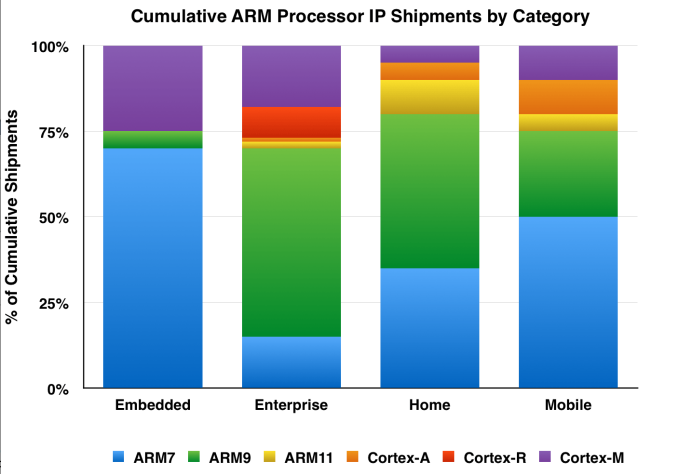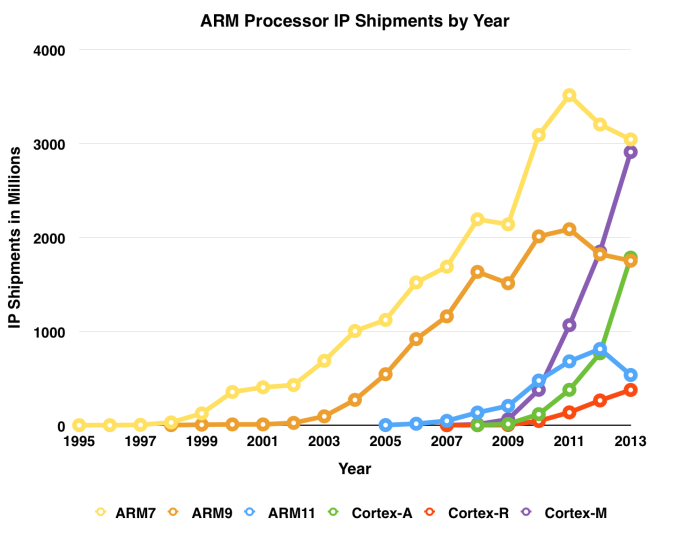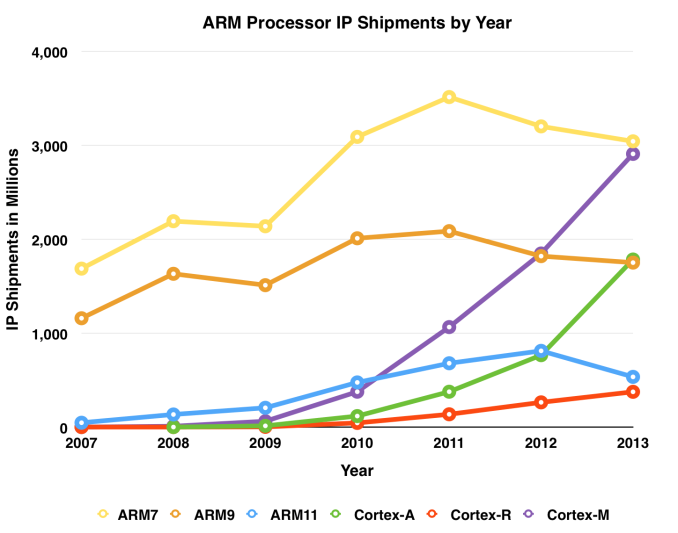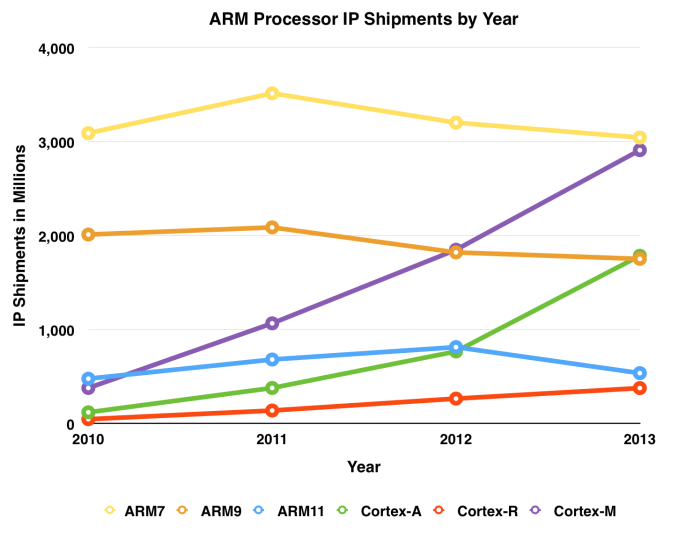ARM Partners Ship 50 Billion Chips Since 1991 - Where Did They Go?
by Anand Lal Shimpi on March 31, 2014 9:00 AM EST- Posted in
- SoCs
- IT Computing
- Arm
- Smartphones
- Mobile
- Enterprise
- Tablets

A few weeks ago ARM celebrated its partners shipping over 10 billion ARM based chips in 2013. As ARM makes a royalty on every IP license shipped, it was a banner year for the company. The bigger story was that the 10 billion in 2013 brought the cumulative total for ARM based processors to over 50 billion (note that these are discrete ICs, multiple cores within a single design are not counted multiple times). ARM's press activities were limited to talking about the big final number, but ARM has a pretty broad IP portfolio. What I wanted was a breakdown of where the 50 billion went, so I asked.
What I got in response were tables of data. I was asked not to share specific numbers, but using the data in graphs was ok - and that's all I wanted to do. We'll start with where the 50 billion went in terms of markets (pictured above). Mobile obviously took the majority of shipments, followed by embedded markets. Remember that ARM cores are used all over the place, including in things like HDD and SSD controllers. The modems that work alongside the main apps processors in mobile devices are also frequently home to ARM processor IP. Intel's Quark project actually came about because Intel needed a low power/low cost core to use internally for various projects and eventually decided to offer it to anyone who wanted it. For those companies that don't have the desire/ability to build and validate their own low power CPU core, they often turn to ARM.
The enterprise slice may be a bit misleading depending on what you define as enterprise. We often refer to enterprise in terms of primary CPU shipments into servers. In this case we're talking about chips that go into things like routers and wireless access points. ARM obviously hopes to take a big portion of the high dollar enterprise CPU market with its ARMv8 based IP in the coming years, but it's not there yet.
The smallest slice, labeled home, is still nearly 3 billion shipments. Here we're talking about things like consumer set top boxes as well as wearables.
Note that 37.5 of the 50 billion chips shipped in the past five years (2009 - 2013). That shouldn't come as a surprise given the overlap between that time period and the rise of modern smartphones and tablets.
While ARM wasn't willing to give me shipments by specific core, it was willing to give me family data:
Two thirds of all ARM mobile shipments are really old ARM7 and ARM9 based designs (remember my point about modems above). Here we get the first hint that the reign of the ARM11 designs (the foundation of the original iPhone) was a small blip in the grand scheme of things - the Cortex A family is really what allowed mobile to grow.
The embedded market is dominated by these lower power cores, although the newer Cortex M designs have made a huge dent. The same is true for the enterprise market, which is indicative of what I said earlier about ARM's enterprise market not yet including primary CPU sockets.
The trends are extremely telling. ARM7 (and ARM9) shipments peaked back in 2011 and have been in a slow decline ever since. Cortex M based designs have been skyrocketing since their introduction and show the most aggressive growth of any ARM line. The Cortex A line shows a similar slope over the past two years, with the ARM11 shipments crossing over in 2012.
The next two charts show the same data but focusing on the past 7 years and past 4 years, respectively:
You can easily correlate the rise in ARM's shipments with the explosion in mobile. It's also interesting to point out that, for the most part, shipments are growing with higher performing product families. A smart man once told me that no one wins by betting against performance. Although ARM definitely has its fair share of area and power optimized designs, ultimately it's the serious focus on performance that's been responsible for the surge over the past few years.
It's worth pointing out that although the shipment numbers we're talking about here are in the billions, there's a point to be made about margin. ARM pointed out that Cortex-A shipments overtook x86 in 2012, but with most Cortex-A based designs shipping at well below $30 it's important to put volume in context.
There's a real opportunity for ARM and its partners to start pushing for even higher end designs in my opinion. Thus far all of the talk about ARM enterprise CPUs has been focused on effectively repurposing smartphone designs for the datacenter. You could argue that the Cortex A57 is more enterprise focused than mobile focused, but the fact remains that it's still small/low power enough to get into a phone. I believe one of the next opportunities for disruption will be if ARM (and/or its partners) build a truly big core, something aimed exclusively at the enterprise (and could be repurposed for notebook/desktop use). I've got to believe that all the big players in the ARM space are working on such a thing. And the implications of even moderate success of such a thing are pretty big (particularly if you look at the impact to server CPU ASPs).














34 Comments
View All Comments
grahaman27 - Monday, March 31, 2014 - link
CHARTS! FRAGMENTATION!I kid.
jjj - Monday, March 31, 2014 - link
ARM entering the server market with small cores has always been just the starting point, the intention to go bigger was always there.Ofc the industry is slow ,first they'll need to gain some market to develop the software ecosystem and might take some time before we see big cores. On the desktop side i keep saying that i wish the ARM guys would define some new standards and have a go at it.Wouldn't it be nice to start with a clean slate and modernize the desktop? Oh well, maybe AMD will sell us the server chips ,maybe Denver is good ,maybe Steam OS gets some ARM machines, or maybe not.StormyParis - Monday, March 31, 2014 - link
60% of 50 billion is 30 billion for mobile, that doesn't make sense any way you slice it, unless we're talking cores, not processors.grahaman27 - Monday, March 31, 2014 - link
since 1995? seems reasonable. How many times have you purchased an ARM-based device in the past 20 years? personally I've purchased at least a dozen, and I am just one person.Penti - Monday, March 31, 2014 - link
It makes perfect sense, a common smart phone uses around 10-15 ARM-cores today, and has always used at least 2-3 ARM-cores back to the feature phone days. ARM licenses cores. The processor IP is per unit (so that can be say 10 per chip) not per chip. IP is the keyword here.HammerStrike - Monday, March 31, 2014 - link
From the first paragraph of the article:"The bigger story was that the 10 billion in 2013 brought the cumulative total for ARM based processors to over 50 billion (note that these are discrete ICs, multiple cores within a single design are not counted multiple times)."
They are not counting individual cores, but discrete IC's. Granted, there may be a couple discrete IC's in each smartphone that ARM is licensing, but it is not an inflated count based on cores.
Latest data I found was 1 billion Android activations as of Sept 2013, with 1.5 million activations/day as of April 2013. So say in the last year they did an extra 750 million device activations (assumes activations/day continues to increase), and maybe another 500 million IOS devices that licensed the specific cores, and you have 2.25 billion "smart" phones. Say they have 3 IC's each on average licensed from ARM (no idea if that is a reasonable number or not, but that's what I'm going with), and you have a total of 6.75 billion chips from smart phones. If that math is within an order of magnitude that means ll the Nokia, Motorola, etc feature phones from the mid-90's on still make up the vast majority of their mobile total. But that would seem to be at odds from Anands statement that "37.5 of the 50 billion chips shipped in the past five years (2009 - 2013)". Either my estimates of smart phones/tablets totals is way off, the amount of licenses ARM gets per unit is significantly underestimated, or there is still a ton of feature phones shipped in the last 5 years.
No longer sure of the overall point of this post, but it's already typed, so I'll submit it.
Death666Angel - Monday, March 31, 2014 - link
Data I found (smartphone shippments):2010: ~300 m
2011: ~500 m
2012: ~650 m
2013: ~ 1 b
= 2.45b
Add to that some few hundred million tablet shipments, laptops, who knows how many dumb and feature phones....
Penti - Monday, March 31, 2014 - link
Read the damn graphs, it clearly says IP shipments! Each ARM core is an IP shipment. If you count IC's then a modern phone basically has a two, three or four ARM-powered chips. In reality these represents over 10 IP licenses from ARM. Just a modern application processor with built modem has at least something like 5-10 ARM cores. Nowadays there is usually a couple of ARM microcontrollers doing other tasks too, stuff like WiFi also includes an embedded cpu-core. Remember the X8 moniker for Moto X? That phone has a dual-core application processor, plus two other ARM cores, plus a couple they didn't count such as the baseband which can contain ARM cores (Intel's and several others does any way) now you have big.LITTLE with 8 cores too, plus the rest of the cores in the system. All from ARM basically. Older phones had like 2-3 cores, newer like 4-10 when it concerns ARM. Most of the sales are from the last five years most def. A few billions units quickly becomes those 37.5 billion, but you can pretty much conclude that those numbers includes wireless broadband cards and so on too.If you just look at the Cortex-A graph, you see that they basically has come up to two billion a year by 2013, less than a billion a year for 12, a couple of hundred for 2011, an just tens of millions in 2010. Yet they didn't sell close to two billion devices with Cortex-A in 2013. Many system there was dual-core, quad-core and so on. Some were single-core, like chips for wifi routers or stuff for older devices.
AndyKH - Wednesday, April 2, 2014 - link
Penti, you should stop being rude and read the first paragraph. Anand specifically emphasizes that the numbers represent discrete ICs containing ARM IP.name99 - Monday, March 31, 2014 - link
cumulative...I've owned an iPhone, iPhone 4, and iPhone 5. And an iPad and iPad3.
Additionally it's possible that every one of these phones (even if you count a dual CPU SOC as just one) had a separate low-power ARM running the RF part of the system. Once you get to iPhone 5S you explicitly have a low-power separate core handling sensors on a separate SOC, and other phones may have had something similar for a while, just didn't talk about it.
I think it's feasible.